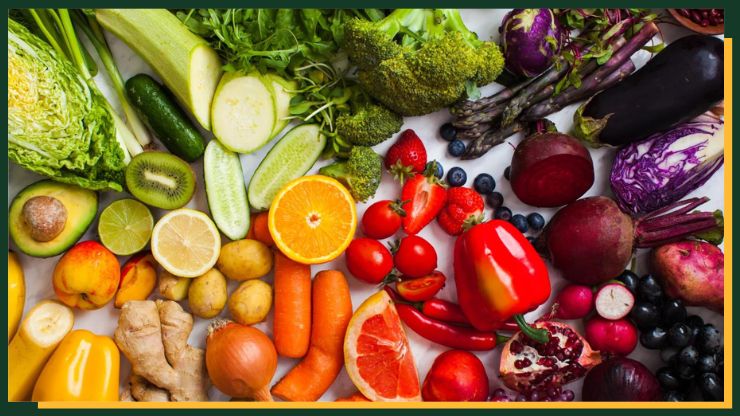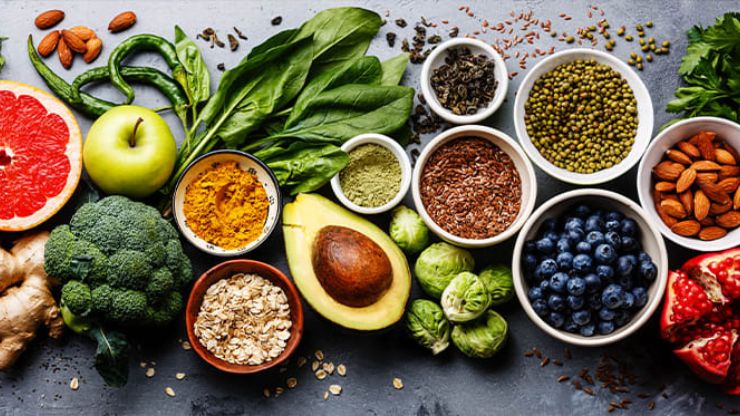Eating Seasonal Produce – In a world marked by industrialized agriculture and globalized food markets, reconnecting with the rhythm of nature by embracing seasonal produce offers a myriad of benefits for both individual well-being and the environment.
Fruits and vegetables that naturally flourish at particular periods of the year, taking advantage of the local temperature and soil conditions to reach their nutritious peak, are referred to as seasonal food. This introduction explores the significance of consuming foods in harmony with the seasons, delving into the heightened nutritional value, vibrant flavors, and eco-friendly advantages associated with this practice.
By understanding the advantages of eating seasonally, individuals can not only optimize their health but also contribute to sustainable agricultural practices, supporting local farmers and reducing the carbon footprint associated with long-distance food transportation. This exploration aims to inspire a shift towards a more mindful and seasonally attuned approach to nutrition.
Table of Contents
ToggleAdvantages of Eating Seasonal Produce
Eating seasonal produce offers numerous advantages for both individuals and the environment.
- Nutritional Benefits: Seasonal fruits and vegetables are harvested at their peak, containing higher levels of vitamins, minerals, and antioxidants, contributing to better overall health.
- Enhanced Flavor: Seasonal produce often has a more robust and fresh flavor, making meals more enjoyable and encouraging a diverse and satisfying diet.
- Environmental Sustainability: Choosing seasonal produce supports local agriculture, reducing the environmental impact associated with long-distance transportation. This promotes sustainable farming practices and helps minimize the carbon footprint.
- Preservative-Free: Seasonal produce typically requires fewer preservatives and artificial ripening agents, leading to a more natural and wholesome food supply.
- Support for Local Economies: Purchasing seasonal produce supports local farmers, fostering economic growth within the community and preserving farmland.
- Biodiversity: Seasonal eating encourages a diverse range of crops, contributing to biodiversity and promoting resilience in the agricultural ecosystem.
Also, Read – Making Miso Paste
How to Identify Seasonal Produce

Recognizing seasonal vegetables requires knowledge of local growing conditions and purchasing awareness. Here’s a guide on how to recognize what’s in season:
- Know Your Local Seasons:
- Learn about the growth seasons and climate of your area. Seasons vary based on location, so what’s in season in one area may not be in another.
- Visit Farmer’s Markets:
- Local farmer’s markets are excellent resources for seasonal produce. Farmers often sell what’s freshly harvested, giving you a clear indication of what’s in season.
- Read Labels and Signs:
- When shopping at grocery stores, pay attention to labels and signs indicating the origin of the produce. Many stores now label items with their source, helping you identify locally grown and potentially seasonal items.
- Observe Price and Availability:
- Seasonal vegetables are often cheaper and easier to find. If you notice a particular fruit or vegetable is in abundance and reasonably priced, it’s likely in season.
- Use Seasonal Calendars:
- Refer to online seasonal produce calendars specific to your region. These resources provide a general guide on when certain fruits and vegetables are likely to be in season.
- Stay Informed:
- Keep up with local agricultural news and updates on community-supported agriculture (CSA). This information can give you insights into what farmers are currently harvesting.
- Join a CSA Program:
- Community-supported agriculture programs often provide subscribers with a variety of seasonal produce directly from local farms. This can be a convenient way to access fresh, seasonal items.
- Ask Local Farmers:
- Engage with local farmers and vendors. They are valuable sources of information about what is currently in season and can provide tips on the best ways to enjoy seasonal produce.
Also, Read – How to Make Lox
Incorporating Seasonal Produce into Your Diet
Incorporating seasonal produce into your diet is a rewarding and health-conscious practice. Here’s a guide on how to seamlessly integrate seasonal fruits and vegetables into your meals:
- Meal Planning:
- Plan your meals based on the availability of seasonal produce. Create menus that are weekly or monthly and in line with the seasonal offerings to ensure freshness and variety.
- Explore Seasonal Recipes:
- Discover and experiment with recipes specifically designed for seasonal ingredients. You can be certain that you are taking full advantage of the unique flavors and health benefits associated with each season if you do this.
- Flexibility in Recipes:
- Be open to adapting recipes based on what’s in season. Replace goods with seasonal alternatives to keep them delicious and fresh.
- Fresh Eating:
- Incorporate seasonal produce into salads, snacks, and side dishes in their raw form to maximize nutritional benefits. This is a simple way to enjoy the natural flavors of fresh fruits and vegetables.
- Freezing and Canning:
- Preserve excess seasonal produce by freezing or canning. This allows you to enjoy your favorite fruits and vegetables even when they are out of season while retaining much of their nutritional value.
- Visit Farmer’s Markets Regularly:
- Make regular visits to local farmer’s markets to stay connected with the seasonal offerings. Building a relationship with local farmers can provide you with insights into the best ways to use and enjoy specific seasonal items.
Challenges and Solutions in Eating Seasonal Produce
Availability in Off-Season:
Don't just scroll, subscribe!
BuzzTrail's unique web-stories are the cure for boredom you've been waiting for.
- Challenge: Limited availability of certain fruits and vegetables during off-seasons.
- Solution: Embrace preservation techniques such as freezing, canning, or drying to enjoy seasonal produce throughout the year. Explore alternatives that are in season, and support local markets providing greenhouse-grown options.
Changing Tastes and Preferences:
- Challenge: Resistance to altering eating habits and preferences.
- Solution: Gradually introduce seasonal items into your diet, experimenting with new recipes and flavors. Over time, taste buds can adapt, and a variety of seasonal options can be incorporated into meals.
Lack of Knowledge:
- Challenge: Difficulty in identifying and understanding what is in season.
- Solution: Stay informed about local growing seasons through online resources, community-supported agriculture (CSA) programs, and farmer’s market visits. Engage with local farmers to gain insights into seasonal availability.
Limited Variety:
- Challenge: Perceived limitations in meal variety due to seasonal constraints.
- Solution: Explore diverse recipes and cooking methods to enhance variety. To keep meals interesting and fulfilling, take advantage of the availability of each season by experimenting with different ingredients and cooking methods.
Convenience Factors:
- Challenge: Convenience of pre-packaged, non-seasonal produce.
- Solution: Plan meals in advance, incorporating seasonal items into your shopping list. Utilize farmer’s markets, local produce stands, and community-supported agriculture programs to access fresh, seasonal options conveniently.
Cost Considerations:
- Challenge: Perceived higher costs associated with organic and seasonal produce.
- Solution: Consider the long-term health benefits and environmental advantages. Explore local markets and farms for potentially more affordable options. Also, be mindful of reduced overall costs when embracing a seasonal, whole-foods based diet.
Limited Access to Local Markets:
- Challenge: Limited access to farmer’s markets or local produce stands.
- Solution: Explore online platforms that connect consumers with local farmers. Participate in community-supported agriculture programs, which often deliver fresh, seasonal produce directly to your doorstep.
Conclusion
In conclusion, adopting a seasonal approach to eating offers a bounty of benefits, from heightened nutritional content to reduced environmental impact. By embracing the variety each season brings, we not only support local agriculture and economies but also promote a healthier, more sustainable lifestyle.
Through conscious choices and a connection to the natural cycles of food production, individuals can savor the flavors of each season while contributing to their well-being and the well-being of the planet. It’s a simple yet impactful way to nourish ourselves and the world around us.
FAQs
Why is eating seasonal produce important?
Why is eating seasonal produce important?
Eating seasonal produce is crucial for several reasons. It ensures higher nutritional content, supports local agriculture, reduces the environmental impact of transportation, and promotes sustainability by aligning with natural growing cycles.
How can I identify what’s in season?
How can I identify what’s in season?
Stay informed about local growing seasons through online resources, visit farmer’s markets, read labels at grocery stores, and engage with local farmers. Seasonal produce calendars specific to your region can also guide you.
What if certain produce is not available in a particular season?
What if certain produce is not available in a particular season?
Embrace preservation techniques like freezing or canning. Alternatively, explore seasonal alternatives or support local markets that may offer greenhouse-grown options.

